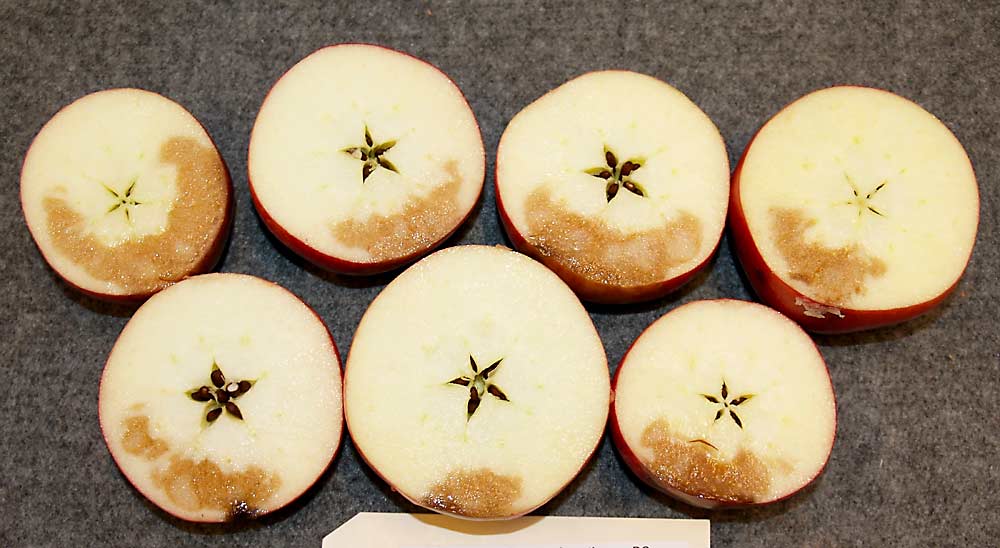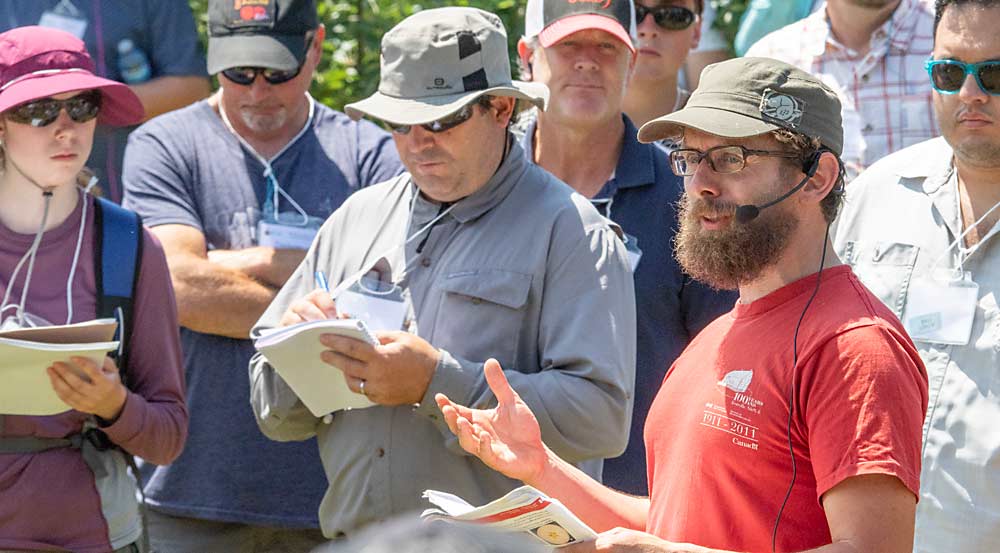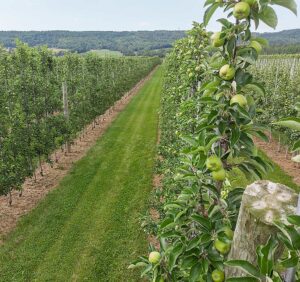
The effects of ethylene inhibitors on storage disorders and fruit quality can be hard to pin down; so much depends on the region, the weather and the year.
Nova Scotia is no different. After a two-year study of the anti-ethylene products Harvista (1-methylcyclopropene) and ReTain (aminoethoxyvinylglycine), researchers in the Canadian province found that they improved fruit quality in Ambrosia and Honeycrisp, but their effects on storage disorders were mixed. Harrison Wright, a research scientist with Agriculture and Agri-Food Canada, shared the results with the International Fruit Tree Association last summer at Van Meekeren Farms in Nova Scotia’s Annapolis Valley. The study was funded by federal, provincial and industry sources, he said.
Previous Nova Scotia studies showed that physiological disorders in Ambrosia and Honeycrisp are connected to maturity. In the latest study, preharvest applications of Harvista and ReTain delayed maturity relative to control fruit for both cultivars, both at harvest and after eight months of controlled atmosphere (CA) storage. But when it came to major physiological disorders, they either had no impact or the impact was inconsistent, Wright said.

Both products were compared with an untreated control over two growing seasons (2020 and 2021) at four sites in the Annapolis Valley. There were two harvest times (optimum and 10 days later). They applied Harvista at a full rate one week before the first (optimum) harvest and ReTain at a half rate two weeks before first harvest. Fruit quality was evaluated at harvest and after eight months of CA storage. Physiological disorders were assessed after eight months of CA storage.
Growing conditions varied between the two seasons, Wright said. Both years were approximately 5 percent warmer than the 10-year average, but precipitation levels varied widely: 8 percent below average in 2020 and 27 percent above average in 2021.
Other findings from Wright’s Nova Scotia study:
—The overall percentage of marketable Ambrosia fruit (free from all physiological disorders and rots) was higher during the first harvest time than the second. This was not affected by treatment or year.
—Fruit treated with ReTain and Harvista showed superior acid retention and chlorophyll levels compared to untreated fruit after eight months of CA storage.
They also studied the effects of preconditioning in Honeycrisp. Preconditioning the fruit at 68 degrees Fahrenheit for seven days decreased incidence of cavities, soggy breakdown and core flush by greater than 80 percent on average, regardless of field treatment, and improved the overall percentage of marketable fruit.
Grower perspective
Van Meekeren Farms was one of the locations where Wright’s team conducted the study. The Van Meekerens store, pack and market apples for themselves and about 10 other growers.

Grower Stephen Van Meekeren said he uses ethylene inhibitors more as a harvest and labor management tool than a storage management tool. He uses ReTain on all of his Galas and some of his Honeycrisps. The two varieties make up about 60 percent of his farm’s 125 acres of apples.
He doesn’t use Harvista often but expects to use it more in the future. Harvista requires extra equipment and sprayer calibrations, which can be “onerous” during a busy time of year, he said, but he can apply it two or three days before the harvest date. That can buy time in case of erratic weather or labor shortages. ReTain, on the other hand, goes right in the sprayer with no extra steps needed, but it can’t be applied as close to harvest as Harvista.
Van Meekeren uses ReTain to help space out his Honeycrisp and Gala harvests and said many of the growers he packs for use it for the same purpose. He typically does a first pick of Honeycrisp in the last week of September, strips all of his Galas in a single pick in the first week of October (after they’ve sized up), then does a second and third pick of Honeycrisp after the Galas are off the trees. He sprays ReTain on all of the Galas and on the late-harvested Honeycrisps.
ReTain also minimizes greasiness and stem cracking in Gala, he said.
As more Honeycrisp plantings come into production, Van Meekeren expects more growers to use Harvista in addition to ReTain. He said they need more tools to stretch the harvest window.
—by Matt Milkovich







Leave A Comment